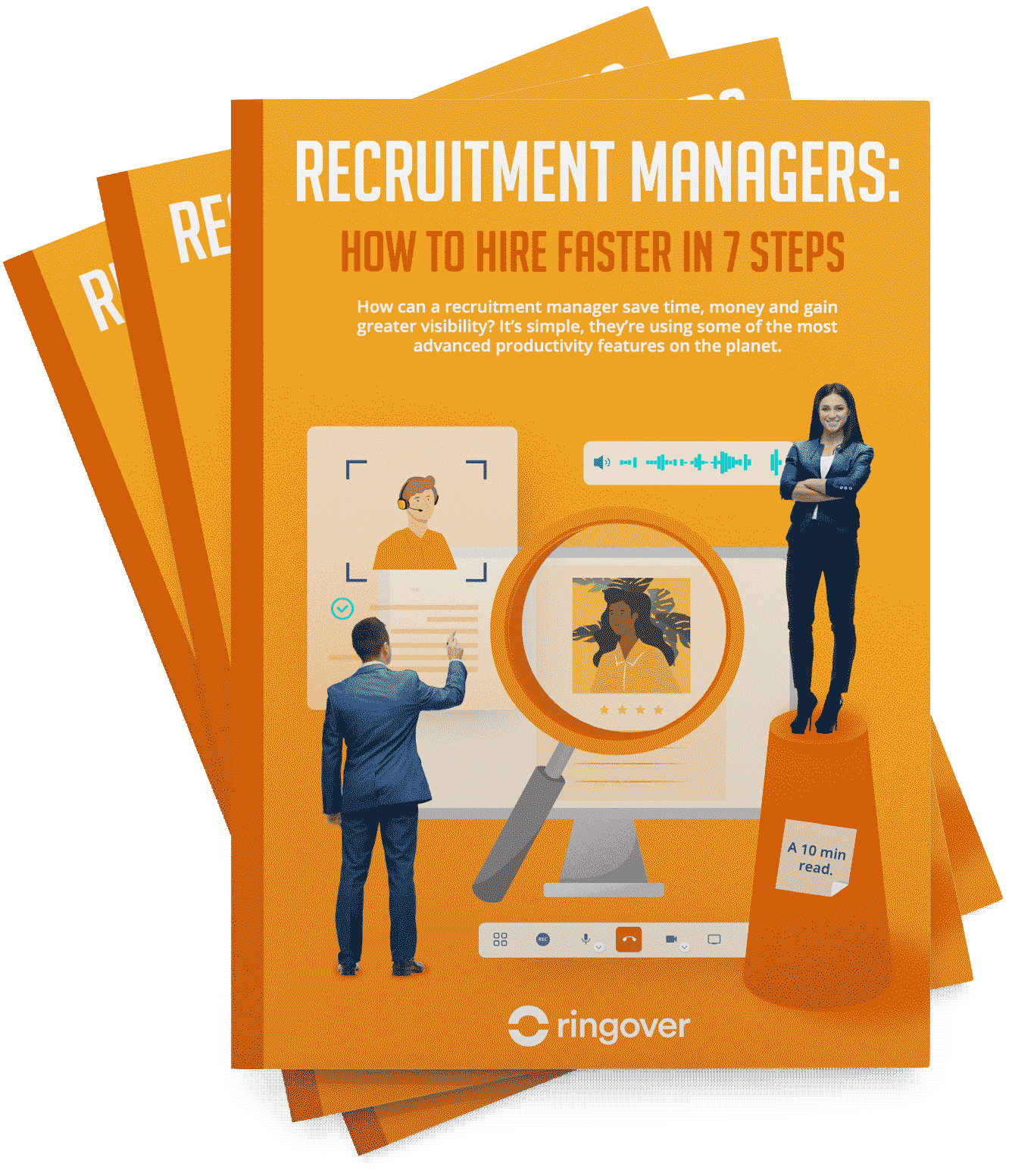Summary
If you've ever wondered how companies consistently attract, develop, and retain top talent, the secret lies in mastering the talent lifecycle. This concept encompasses the entire journey an employee undergoes within an organisation, starting from recruitment and onboarding to performance management, learning and development, succession planning, and beyond.
Discover Ringover for Recruitment
Effectively managing this continuous cycle enhances employee engagement and growth, ensuring businesses attract and retain the top talent essential for sustained success. From building a compelling employer brand to supporting personalised development plans and nurturing a positive employee experience, each stage plays a pivotal role in optimising performance management. This article will explore key stages, share best practices, and help you develop a winning talent lifecycle strategy that drives long-term growth.
What is a talent lifecycle?
The talent lifecycle is a comprehensive framework that outlines the entire journey of an employee within a company or organisation. It encompasses every stage, from attracting and recruiting the right talent to nurturing their growth, enhancing their performance, and managing their eventual departure or retention. This lifecycle ensures that talent management is not a one-time event but a continuous cycle of development and engagement, aimed at maximising both employee satisfaction and organisational success.
Typically, the talent lifecycle is divided into five essential stages:
- Recruitment process: Identifying talent needs, attracting candidates, and hiring skilled individuals who align with the company's goals and culture.
- Onboarding: Introducing new employees to their roles, immersing them in the company culture, and providing the necessary resources for a smooth start.
- Engagement: Fostering a sense of belonging and aligning employees with the company's values to boost employee engagement and loyalty.
- Learning and Development: Providing ongoing training and skill development opportunities to enhance performance and prepare employees for future roles.
- Offboarding: Managing the transition when employees leave, ensuring knowledge transfer and maintaining positive relationships.
By strategically managing each of these phases as part of the talent management lifecycle, companies can strengthen their employer brand, retain top performers, and align talent development with long-term business objectives. Neglecting any stage can result in high turnover, a diminished employee experience, and a less effective workforce overall.
In essence, the talent lifecycle goes beyond hiring and firing — it is a holistic approach that integrates performance management, employee development, and succession planning. This creates a resilient and empowered workforce that evolves with the business, fostering sustainable success at every stage of the employee life cycle.
What is the talent acquisition lifecycle?
The talent acquisition lifecycle is a structured process within the broader talent lifecycle that focuses on how a company identifies, attracts, assesses, and hires the best-fit candidates for its needs. This process is essential for aligning recruitment strategies with long-term business objectives, ensuring that the organisation acquires the right skills to drive success.
The key phases of the talent acquisition lifecycle typically include:
- Workforce Planning: This initial stage involves analysing current workforce capabilities, forecasting future hiring needs, and identifying skill gaps based on the company's strategic goals. Effective workforce planning provides direction for sourcing top talent aligned with long-term organisational requirements.
- Talent Sourcing: Companies actively search for and attract potential candidates using various channels such as job boards, social media, employee referrals, and professional networks. The diversity and quality of candidates sourced at this stage are vital for building a strong talent pipeline.
- Candidate Screening: During this phase, applicants who do not meet the job criteria are filtered out, ensuring that only qualified candidates move forward. Screening methods may include resume reviews, phone interviews, and initial assessments to streamline the hiring process.
- Interviewing and Assessment: This stage involves in-depth evaluations, such as structured interviews, technical tests, and behavioural assessments, to determine cultural fit and the candidate's potential for success within the company.
- Offer and Onboarding: After selecting a candidate, the offer is extended, and the onboarding process begins. A well-designed onboarding experience is essential for integrating new employees quickly, enhancing early engagement, and improving retention.
Mastering these stages within the talent acquisition lifecycle helps organisations not only fill vacancies efficiently but also strengthens their employer brand and lays the groundwork for ongoing employee development and engagement. Ultimately, this lifecycle is a critical subset of the broader talent management lifecycle, focusing on the initial and most impactful stages of an employee's journey within the company.
Integrating Ringover with your ATS seamlessly tracks candidate information, allowing you to easily track interactions and place candidates more efficiently.
Talent Lifecycle Steps
The talent lifecycle is a dynamic process that includes multiple interconnected stages to manage an employee's journey from initial attraction to eventual exit. Each step ensures alignment with organisational goals and helps companies build a strong talent management lifecycle that fosters growth and enhances their employer brand.
Here are the core steps that define the talent lifecycle stages:
- Attraction: This step emphasises creating a compelling employer brand that appeals to potential candidates. Companies showcase their culture, values, and growth opportunities across various platforms to attract top talent and stand out in a competitive market.
- Recruitment and Selection: After attracting candidates, this stage involves screening, interviewing, and assessing to find the best fit for both the company and the employee. It considers skills, qualifications, and cultural alignment.
- Onboarding: A structured onboarding process helps new hires integrate smoothly, become productive quickly, and feel connected to the organisation. This reduces turnover and enhances the overall employee experience.
- Engagement and Retention: Maintaining employee motivation and loyalty is essential. Companies focus on high levels of employee engagement through meaningful work, recognition, and a supportive environment to retain top performers.
- Learning and Development: This stage encourages continuous skill-building through training, coaching, and personalised individual development plans. It enables employees to grow, contribute effectively, and prepare for future roles within the organisation.
- Performance Management: Regular evaluation and feedback align individual goals with company objectives. This ensures employees are supported in meeting expectations and advancing their careers as part of the management lifecycle.
- Succession Planning and Offboarding: Effective succession planning ensures leadership continuity. When employees leave, a structured offboarding process facilitates knowledge transfer and maintains positive relationships, supporting a strong talent management strategy over the long term.
Each of these stages is essential for creating a seamless employee life cycle that nurtures talent holistically, supports business growth, and keeps organisations competitive by attracting, developing, and retaining top performers. By optimising every phase, companies can build a resilient workforce aligned with their strategic goals.
How to Build an Effective Talent Lifecycle Strategy
Developing a robust talent lifecycle strategy is essential for any organisation aiming to nurture and retain excellent employees while driving business success. Here are practical steps to help you create and implement an effective strategy:
Define Business and Talent Priorities
Start by aligning your talent lifecycle goals with your company's overall business objectives. Understand the skills and roles that matter most to your growth and how the talent management processes will support these priorities.
Map Out Your Talent Lifecycle Stages
Clearly outline each stage—from attraction and recruitment to onboarding, development, performance management, and succession planning. Tailor each phase to enhance the employee experience and maximise employee engagement.
Build an Effective Technology Stack
Modern talent lifecycle management requires smart tools that streamline processes and improve outcomes. For example, Ringover's business phone system offers call tracking, call recording, and integrated omnichannel communication software (including WhatsApp!) that facilitates seamless candidate and employee interactions. Paired with Empower by Ringover, a conversation intelligence software, you benefit from semantic analysis, personalised advice to improve performance, and automatic call transcription and summaries, accelerating recruitment and staffing efforts.
Both Ringover and Empower can be integrated with popular applicant tracking systems (ATS) like Bullhorn and Vincere, allowing your recruitment teams to centralise communication and candidate data. This integration optimises the hiring process by ensuring timely follow-ups and personalised candidate engagement, making it easier to attract and retain top talent.
Invest in Continuous Learning and Development
Support ongoing skill-building to help employees grow within the company. Use data-driven approaches to create personalised learning paths and track progress through individual development plans.
Implement Regular Performance Management
Establish clear performance metrics, provide ongoing feedback, and recognise achievements. This keeps employees motivated, aligned with company goals, and prepared for future roles.
Focus on Employee Retention and Succession Planning
Engage employees by fostering a strong company culture and offering career advancement opportunities. Succession planning ensures leadership continuity and helps retain critical talent.
Measure and Optimize
Regularly review talent lifecycle metrics such as time-to-fill, retention rates, employee satisfaction, and performance outcomes. Use this data to refine your strategy and address gaps in the process.
Conclusion: Talent Lifecycle
Understanding and implementing a comprehensive talent lifecycle is essential for organisations seeking to attract, develop, and retain high-performing employees. By focusing on each stage—from recruitment and onboarding to ongoing development and succession planning—you establish a seamless cycle that enhances your company culture and increases employee engagement. Utilising modern tools and clear strategies ensures your workforce remains agile and aligned with your business objectives.
Now is the time to take action: evaluate your current talent management practices, identify areas for improvement, and design a resilient talent lifecycle strategy to achieve long-term success.
Talent Lifecycle FAQ
What are the 5 C's of talent?
The 5 C's of talent refer to key qualities that define effective business talent:
- Competence (skills and knowledge to perform tasks)
- Character (integrity and attitude)
- Collaboration (ability to work well with others)
- Communication (clear and effective interaction)
- Commitment (dedication to excellence and continuous learning)
Together, these attributes create a well-rounded, high-performing employee who can contribute meaningfully to an organisation's success.
What are the 5 steps of talent management?
The 5 steps of talent management generally include:
- Workforce Planning to identify talent needs
- Talent Acquisition involving recruitment and selection
- Onboarding to integrate new hires efficiently
- Employee Development through training and continuous learning opportunities
- Performance Management to monitor, evaluate, and enhance employee contributions
These steps work together to optimise the overall employee lifecycle and improve business outcomes.
What are the 7 stages of the employee lifecycle?
The 7 stages of the employee lifecycle expand on the employee experience and include:
- Attraction, where you build a compelling employer brand
- Recruitment to select the right candidates
- Onboarding to acclimate employees
- Development focused on skill enhancement
- Retention through engagement and culture
- Performance Management to align goals and provide feedback
- Separation, where employees exit the company in a planned, positive manner
Managing these stages effectively ensures a seamless and productive talent lifecycle management process.
Published on July 7, 2025.



